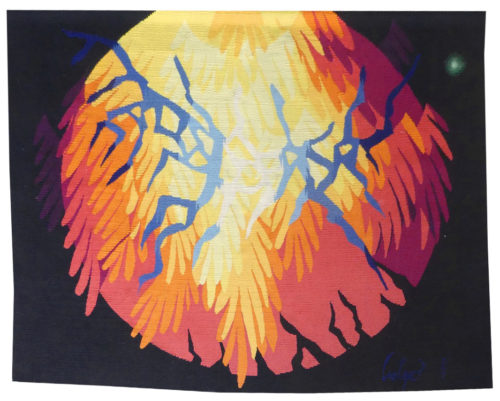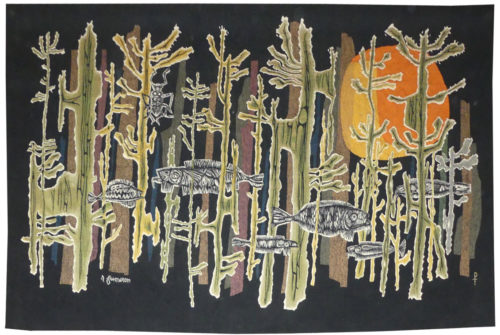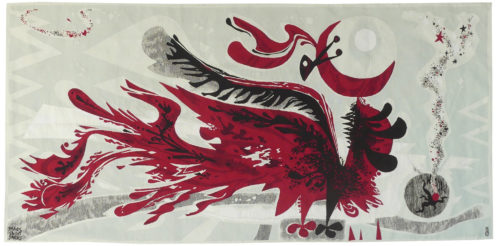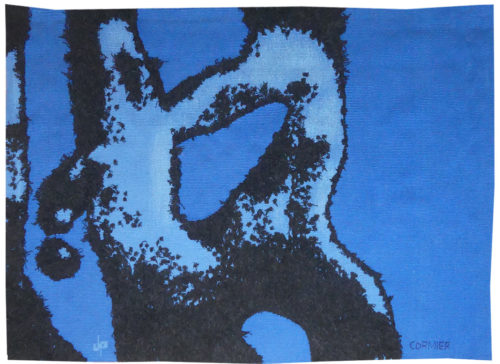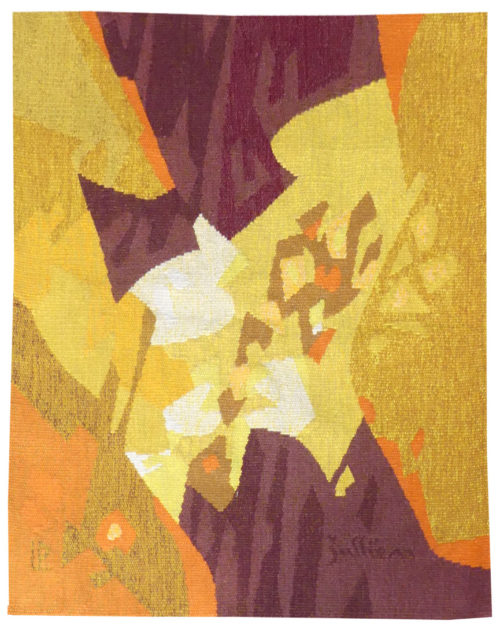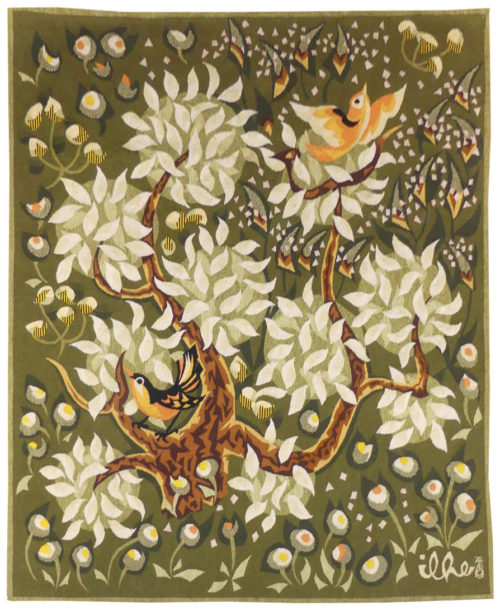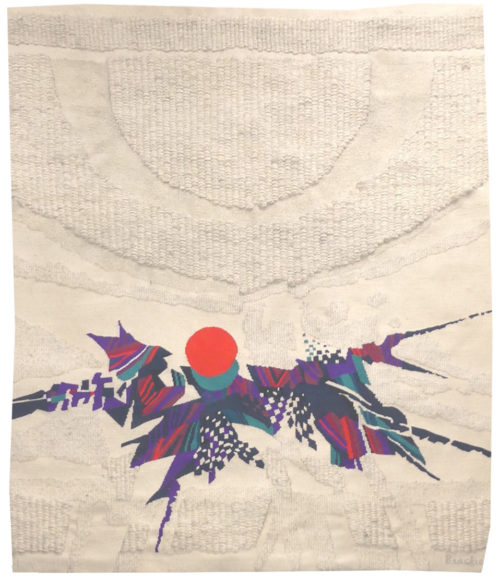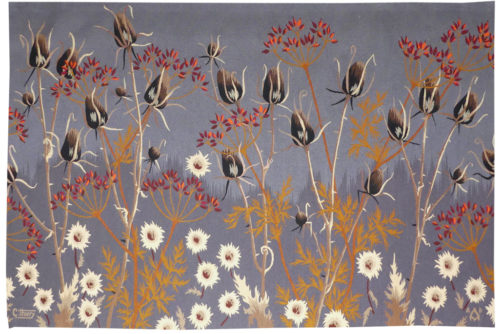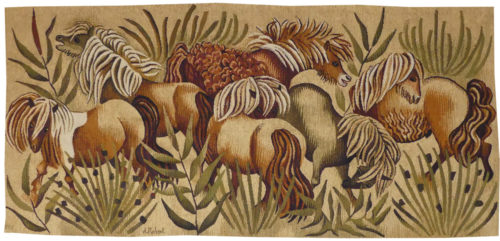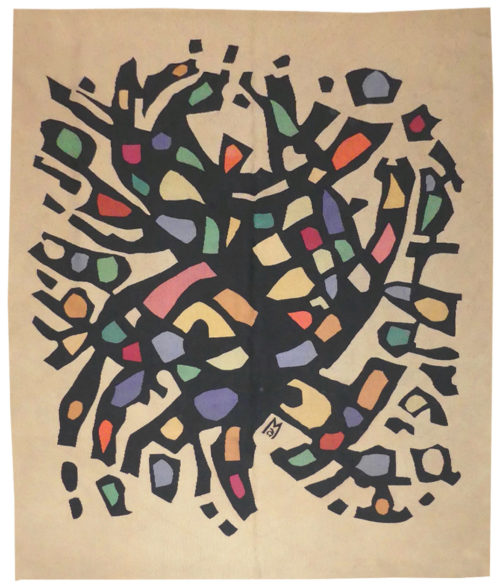-
Aubusson tapestry woven in the Pinton workshop. With signed label. Circa 1960.Fumeron designed his first cartoons (he would ultimately make over 500) in the 1940’s, in collaboration with the Pinton workshop, he was then commissioned on numerous occasions by the state before participating in the decoration of the ocean liner “France”. His work was figurative to begin with and influenced by Lurçat, then turned towards abstraction, before coming back to a style characterised by colourful figurative and realistic depictions from the 1980’s onwards. The vertical fronds, through which mottled fish weave in and out, partially hide a flaming red sun : in this piece we recognise all the elements of Fumeron’s characteristically fantastical vision.
-
Bel canto
Lurçat approached Saint-Saëns, originally a painter of murals, in 1940. And during the war the latter produced the first of his allegorical masterpieces, tapestries reflecting indignation, combat, resistance : “les Vierges folles (the foolish virgins), “Thésée et le Minotaure” (Theseus and the Minotaur). At the end of the war, as a natural development he joined up with Lurçat, whose convictions he shared (concerning a simplified palette, outlined cartoons with colours indicated by pre-ordained numbers, and the specific nature of tapestry design…) at the A.P.C.T. (Association des Peintres-cartonniers de Tapisserie). His universe, where the human figure, stretched, elongated, ooccupies an important place (particularly when compared to his companions Lurçat or Picart le Doux), pivots around traditional themes : woman, the Commedia dell’arte, Greek mythology… refined by the brilliance of the colours and the simplification of the layout. His work would evolve later, in the 1960’s, towards cartoons of a more lyrical design, almost abstract where elemental and cosmic forces would dominate. If Music as a theme is ever-present in Saint-Saëns’s work, the changes that his style underwent in the 1960’s towards a vision that is both more informal and biomorphic, influenced his treatment of it ; but is not the lyricism evident in this piece ideally suited to the expression “Bel Canto” ? Bibliography : Exhibition catalogue La tapisserie française du Moyen-âge à nos jours, Paris, Musée d’art moderne, 1946 Exhibition catalogue Saint-Saëns, Paris, galerie La Demeure, 1970, ill. Exhibition catalogue Saint-Saëns, the tapestries, Aubusson, Musée départemental de la Tapisserie, 1987 Exhibition catalogue Marc Saint-Saëns, tapestries, 1935-1979, Angers, Musée Jean Lurçat et de la Tapisserie Contemporaine 1997-1998Aubusson tapestry woven by the Tabard workshop. N°4. 1964. -
Composition
It is perhaps the association with Pierre Vago, the architect who was her husband, that inspired Nicole Cormier to take an interest in mural art (cv. “Soleil levant” for the university at Villeneuve d’Ascq) ; in the 1970’s she designed and made hangings sewn from felt and cotton textiles and designed cartoons for tapestries some of which were woven by Pierre Daquin notably.Tapestry woven in the Saint-Cyr workshop. With signed label, n°EA1. Circa 1980. -
Coquerelle (Pasque flower)
After the traditional completion of some mural paintings in the 1930’s, he then arrived in Aubusson in 1936, became closely associated with Picart le Doux in 1947 and then joined the A.P.C.T. (Association des Peintres-Cartonniers de Tapisserie). From then on he devoted himself to tapestry with zeal and designed 167 cartoons, at first figurative following on from Picart le Doux and Saint-Saëns, then, influenced by the scientific themes that he dealt with, tending more towards abstraction. In 1981, two years before his death, he donated his studio to the Musée départemental de la tapisserie in Aubusson. Rather than the purple colour, it is the sound of the name of the flower that was the effect desired by Jullien for the title of this piece. It is contemporaneous with another piece titled “Capucine” which was woven to the same dimensions. Bibliography : Exhibition catalogue Hommage à Louis-Marie Jullien, Aubusson, Musée départemental de la Tapisserie, 1983Aubusson tapestry woven in the Legoueix workshop. With label, n°4/6. 1967. -
Matines (matins)
Henri Ilhe, who came to the design of tapestry cartoons late on in his career, still managed to produce from 1964 onwards a considerable number (more than 120, all woven by the Tabard workshop) in an urbane style, incorporating birds and butterflies sporting in and around the gnarled branches of trees and bushes. The title of this piece evokes a certain community of spirit with Dom Robert in the mingling of rural concerns and monastic life.Aubusson tapestry woven in the Tabard workshop. With signed label, n°5. Circa 1970. -
Hommage à Yukio Mishima (A tribute to Yukio Mishima)
Tapestry woven in the Saint-Cyr workshop. With signed label, n°EA1. 1972.Jacques Brachet was an important protagonist of the « New Tapestry » movement ; woven by Pierre Daquin, exhibited by the « La Demeure » gallery in the 1970’s, his innovative and experimental approach to the medium, from the 1950’s onwards, was recognised by the Centre International d’études pédagogiques in Sèvres, by the scenography of “La Tapisserie en France, 1945 – 1985, la tradition vivante” at the Ecole Nationale Supérieure des Beaux-Arts, and by his inclusion in various promotional events right up to the present day. Brachet travelled to Japan in 1972. The specific techniques of his tapestry designs (as opposed to painting) : innovative use of shape and texture, themes taken from the natural world... would take off in new directions as a result. Paradoxically this particulat hommage to one of the most flamboyant and tragic figures of post-war Japan is, as a textile object, rather tame respecting the 2 dimensional norm, a classic wool weave... The brightly coloured motifs (dominated by a red disk-shaped sun) are in contrast with the white background, like a shard of light on the blade of the seppuku. Bibliography : Madeleine Jarry, la tapisserie art du XXe siècle, Office du livre, 1974, ill. n°157 Exhibition catalogue Jacques Brachet, mémoires océanes, Angers, Musée Jean Lurçat et de la tapisserie contemporaine, 1996 -
Jardin sauvage (wild garden)
A student of Léon Detroy, Gaston Thiéry is one of the last representatives of the Crozant school of painting. Estalished in the Creuse region of France, he started working on tapestries in 1965 with the Andraud workshop for whom he designed cartoons inspired by the local flora, in a decorative style which can be situated somewhere between that of Dom Robert and Maingonnat, a world away from his landscape paintings which were strongly influenced by the impressionists.Aubusson tapestry woven in the Andraud workshop. With label, n°6/8. 1970. -
Technique de groupe (group technique)
Aubusson tapestry woven in the Novion workshop. With label. 1973.A Benedictine monk and an illuminator, Dom Robert met Jean Lurçat in 1941 at the Abbey of En Calcat : while he never abandoned drawing (his watercolours, painted to life, would serve him as a reservoir of ideas for his tapestries), his work as a cartoonist (he was a member of the A.P.C.T. from its inception) would take on a considerable importance (at least a hundred cartoons, all numbered) and would be highly thought of. His immediately recognisable style, absence of perspective¸motifs inspired from the natural world (in a Paradisiac style) where stylised flora and fauna combine in a festive and extrovert exuberance, where the influence of mediaeval tapestry can be clearly felt ; poetic and colourful, Dom Robert’s cartoons are the incarnation of their author’s spiritual asceticism. Inaugurated in the Spring of 2015, the musée Dom Robert opened its doors in in the monastery-school in Sorèze in the department of the Tarn. Although the theme of horses runs through a lot of Dom Robert’s work (cf. “Dartmoor”, “Compagnons de la Marjolaine”, « Farfadet » …), what makes « Technique de groupe » particularly interesting is its origin and the technical aspects of its realisation : unusually, this cartoon is not numbered ; it was Novion, at the time a teacher at the Ecole Nationale d’Art Décoratif in Aubusson, who asked dom Robert to make a watercolour (now held at the museum in Sorèze), thus allowing the weaver more interpretative freedom, and a very different end result, from work made by the workshops of Goubely or Tabard. Bibliography : Cat. Expo. Dom Robert, tapisseries récentes, Paris, Galerie la Demeure, 1974, ill. p.9 Multi-authored, Dom Robert, Tapisseries, Editions Julliard, 1980, ill. p.68-69 Multi-authored, Dom Robert, Tapisseries, Editions Siloë-Sodec, 1990, ill. p.116-117 Exhibition Catalogue, Dom Robert, œuvre tissé, Angers, Musée Jean Lurçat et de la tapisserie contemporaine, 1990, ill. Multi-authored, la clef des champs, Dom Robert, Editions Privat, 2003, ill. p. 109 -
Tapis de sol (Floor carpet)
Manessier was trained in the Bissière studio where he became familiar with decorative art (the sets for the 1937 Exhibition), and with applied arts particularly in the context of religious art (cartoons for stained glass, the design of liturgical ornamentation,...), and designed his first tapestry cartoon in 1947. Somewhat disappointed with the results, too well-defined and arid for his taste, he turned in the 1950’s to the Plasse le Caisne workshop. Exploiting a different technique which allowed for the contrast of stitches, materials, the use of relief, ... and a greater freedom for the weaver who thus engaged in a close collaboration with the cartoon designer, Plasse le Caisne went on to weave most of Manessier’s tapestries, some of them particularly large-scale (“Chant Grégorien” for the Maison de la Radio,...), some of them forming a cycle (the 12 “Cantiques sprituels de Saint Jean de la Croix),... Very much a one-off in Manessier’s work : a rug, but woven using the Aubusson weaving technique in the Goubely workshop (the only time they worked for the artist) ; it was a commission from Myriam Prévot, co-director of the Galerie de France, which was very active in the promotion of most of the non-figurative and lyrical abstract painters (organising 7 separate exhibitions devoted to Manessier), for her flat on the quai d’Anjou : underlying the close relationship between the artist and the gallery owner who represented him. Bibliography : Exhibition Catalogue Manessier, oeuvre tissé, Eglise du château de Felletin, 1993 (ill. p.39)Aubusson carpet/tapestry woven by the Goubely workshop. 1959.


